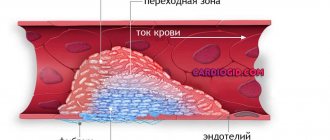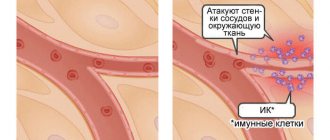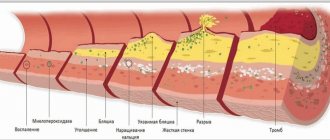The enzyme alpha-amylase is an organic protein substance synthesized in the human body. The main producers of the enzyme are the mixed secretion pancreas and the exocrine (exocrine) salivary glands. The enzyme is detected in minute amounts in the liver, lungs, kidneys, intestines, and uterine appendages in women.
During examination, the substance is found in biological fluids (urine and blood). Its concentration must comply with accepted standards for laboratory microscopy. Alpha-amylase in the blood is reduced most often in liver pathologies and tumor processes. An elevated level of the enzyme indicates the development of pancreatic pathologies.
Reference! Alpha-amylase is found in animals and humans; β-amylase and γ-amylase are active in plants.
Total α-amylase in the blood is divided into pancreatic diastase (P-type) and salivary amylase (S-type), in a percentage ratio of 40% to 60%. The main purpose of amylase is the breakdown of complex carbohydrates (glycogen and starch) into their constituent monosaccharides and their residues.
In laboratory diagnostics of urine, diastase (pancreatic α-amylase filtered in the renal apparatus) and the concentration of alpha enzyme in the blood are assessed. A urine test is considered more informative, since filtration and excretion of the substance is carried out by the renal apparatus. A small amount of pancreatic enzyme enters the systemic circulation.
Normal blood amylase levels
By gender, alpha-amylase standards are practically the same. A slight difference in indicators is allowed in women during the perinatal period. This is due to changes in hormonal status, body weight, gastronomic preferences, which affects the qualitative and quantitative content of biologically active substances in the body. Amylase concentrations in pregnant women are assessed as part of routine screenings.
If there are significant discrepancies between the results in relation to the reference values, the pregnant woman is indicated for hospitalization with additional examination. Women in the premenopausal period and during menopause are recommended to monitor amylase levels in the blood and urine annually. The reason is hormonal changes in the female body.
According to the age criterion, the level of pancreatic enzyme increases as the child grows older. Stable indicators are recorded in adults from 18 to 70 years. In people 70+, an increase in values is associated with age-related changes in the body, and is not considered a pathology.
The measurement value for alpha-amylase in a biochemical blood test is U/L (units per liter). Some laboratories measure using the International System of Units (SI). To convert units/l to the SI system, the result must be multiplied by a factor of 0.688.
Table of normative indicators of total amylase
| Infants up to one year old | Children from one to 10 years old | Children and adolescents up to adulthood | Adults about 18 to 40 years old | Elderly people (70+) |
| up to 8 units/l | up to 30 units/l | from 25 to 40 units/l | from 25 to 125 units/l | up to 160 units/l |
Deviations in the analysis results, upward or downward, by more than 30 units in adults, and by 10 units in children, indicate the development of inflammatory processes, acute conditions and chronic diseases. If a high level of pancreatic enzyme is a clinical sign of pathology, then low amylase in the blood does not indicate a specific disease.
In this case, the analysis must be carried out several times. If alpha enzyme levels are consistently reduced, the patient is prescribed additional laboratory tests and hardware diagnostic procedures.
Role and functions of amylase
The named connection has only two tasks.
First
Concerns metabolic processes throughout the body. The substance is capable of converting starch into saccharides. The same structures that, when split, turn into energy and are stored in various forms.
Amylase is directly involved in this process and accelerates it. At the same time, like all catalysts, after the reaction, it is not consumed by itself. It can be reused, which is exactly what is observed in the human body.
Second
Digestive process. Amylase is also involved in the normal processing of substances that enter the gastrointestinal tract.
For example, when starch enters the body, it comes into play first. Along with digestive juices. To quickly process and deposit useful substances. Sources of potential energy, which can be called carbohydrates.
Amylase in the blood is a catalyst (accelerator) of metabolic processes, the very ones that contribute to the formation of energetically valuable compounds. Without it, the body cannot function.
Reasons for low performance
Low amylase levels are not abnormal in young children. Due to the characteristics of the baby’s diet and digestive system, a small amount of pancreatic enzyme is sufficient. The main part of amylase is found in the baby's salivary glands, helping him to fully absorb breast milk.
The activity of amylase and other digestive enzymes may be reduced in children due to the severe congenital pathology of muscovidesis. The disease is characterized by dysfunction of the exocrine glands and the functioning of the digestive and respiratory organs. The cause of the disease is the inheritance of damaged genes from both parents (autosomal recessive inheritance). Infants in the first year of life with this diagnosis have an extremely unfavorable prognosis.
A pathological abnormality associated with enzyme deficiency is fermentopathy. The disease may be congenital or acquired. In the first case, the decisive factor in the occurrence of digestive abnormalities is a genetic cause. In the second, stable eating disorders or chronic pathologies of the gastrointestinal tract (gastrointestinal tract).
Other reasons for decreased alpha-amylase concentrations are associated with diseases of the hepatobiliary system:
- Irreversible transformation of hepatocytes (liver cells) into connective tissue – cirrhosis. By nature of origin it can be viral, alcoholic, metabolic and nutritional.
- Chronic inflammatory liver damage - hepatitis. The chronic form develops as a result of incorrect therapy or patient violation of the rules for treating viral hepatitis A, B, C.
Deviations in the analysis parameters are observed in case of mechanical damage (tissue rupture, blood vessels, bruises, wounds, etc.) of the digestive system. The level of alpha-amylase in this case can be either lower than normal or higher. Reduced enzyme activity is recorded in the postoperative period in patients who have undergone surgery on the abdominal organs.
The most common reason is partial resection or complete removal of the pancreas (pancreatectomy). Another cause of enzyme deficiency is extreme pancreatitis, characterized by the death of pancreatic cells - pancreatic necrosis. The degeneration of cells and tissues of the body, with the loss of the ability to produce biologically active substances, accompanies cancer. In severe stages of cancer, the synthesis of enzymes, hormones, etc. decreases or completely stops.
The only treatment for pancreatic necrosis is pancreatic necrectomy
A rare pathology in which the concentration of amylase is disrupted is benign macroamylasemia (an abnormal combination of enzyme molecules with other blood molecules). A low level of α-amylase in the blood of women during pregnancy characterizes toxicosis of pregnant women.
With insufficient production of alpha-amylase, overactivity of the thyroid gland often occurs - hyperthyroidism or excess production of hormones. Regardless of the reason, a lack of an enzyme inhibits the full functioning of the digestive organs. The body is not able to properly process and absorb nutrients (fats, proteins, carbohydrates). Metabolism is disrupted, diseases of the gastrointestinal tract and endocrine system progress.
What to do if amylase is low?
Low levels of the enzyme are much less common than high levels. Such changes in the analysis are typical for pancreatic failure, cystic fibrosis, severe liver damage (liver failure), pancreaectomy (removal of the pancreas).
Increased blood cholesterol levels can lead to low pancreatic amylase levels. In children of the first year of life, the level of the enzyme is much lower than in adults. This is due to the fact that the food they receive is devoid of sufficient amounts of complex carbohydrates.
When is laboratory diagnostics necessary?
α-amylase is included in the list of indicators to be assessed as part of a biochemical blood test. This is a method of laboratory research of the physical properties and chemical composition of blood, which allows one to assess the functionality of internal organs and identify possible disorders.
The analysis is prescribed:
- for symptomatic patient complaints;
- for prevention purposes;
- to control the therapy.
The main direction of research into the digestive enzyme (pancreatic amylase) is the timely diagnosis and control of treatment of pancreatic diseases. Emergency diagnostics of alpha-amylase levels is carried out if:
- for acute inflammation of the pancreas (acute pancreatitis);
- inflammation of the serous covering of the peritoneum (peritonitis);
- ectopic pregnancy.
Important! With a high level of α-amylase in the blood against the background of acute pain in the left abdomen, radiating to the left clavicle and lower back, nausea and vomiting, accompanied by low-grade body temperature (37–38 °C), acute pancreatitis is 100% diagnosed.
Regular blood microscopy to determine the level of alpha-amylase is necessary for diabetics, patients with chronic pathologies of the pancreas and liver, and cancer patients. The blood sampling procedure is carried out in a laboratory, in the morning, and strictly on an empty stomach. To obtain objective final data, the patient is recommended to:
- three days before the analysis, eliminate fatty foods, hot seasonings and spices, and alcoholic beverages from the diet;
- stop taking medications (diuretics, enzymatic, hormone-containing, non-steroidal anti-inflammatory drugs);
- On the eve of the procedure, limit sports and other physical activities.
The duration of fasting before the study is 8–12 hours.
Additionally
Elevated enzyme values in the results of biochemical examination are determined much more often than low values. A high concentration of α-amylase indicates possible diseases:
- pancreatitis and pancreatic cancer;
- intestinal obstruction;
- diabetes mellitus and diabetic ketoacidosis;
- peptic ulcer of the duodenum and stomach;
- ectopic pregnancy;
- cholelithiasis and urolithiasis;
- CRF, chronic renal failure;
- alcoholism;
- parasitic infestations;
- mumps (mumps);
- appendicitis.
If the test results deviate from the norm, the patient requires additional examination.
What is dangerous about changes in amylase levels?
In itself, the condition when amylase is elevated does not have clinical consequences for the body, however, it is an important marker of pancreatic damage. If an increase in the enzyme index is detected, the analysis is usually monitored within 24 hours, which makes it possible to assess the dynamics of the pathological process.
A decrease in the level of the enzyme against the background of deterioration in the patient’s well-being indicates severe destruction of pancreatic tissue.
You should pay close attention to the situation. full list of questions ‹ Previous page | Next page >
Results
Alpha amylase is an essential digestive enzyme synthesized by the pancreas and salivary glands. The concentration of the substance in the body is determined through a biochemical analysis of blood and urine. If the values decrease below the reference values, the doctor may suspect the development of liver pathologies and hyperthyroidism. In children, the cause of the disorder is genetic pathologies of enzyme production (muscovidosis, enzymopathy).
The lower limit of normal for adult men and women of reproductive age is considered to be 25 units/l. (top – 125 units/l). In children, normative indicators depend on age. If the indicators change in one direction or another, it is necessary to undergo additional diagnostics, including laboratory tests and hardware procedures (ultrasound, MRI, CT, etc.).











